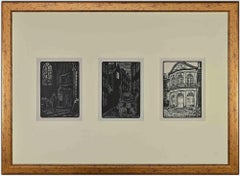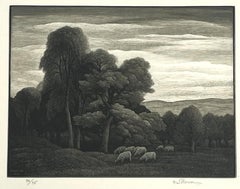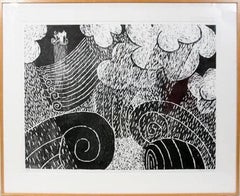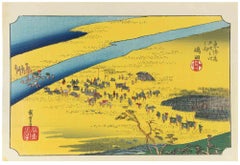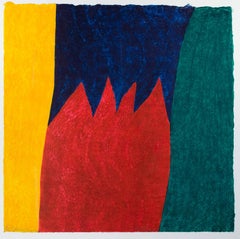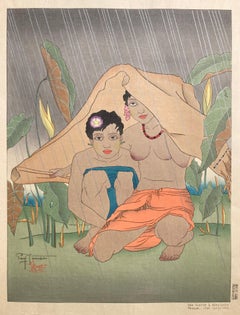Woodcut Landscape Prints
to
314
591
118
51
33
33
Overall Width
to
Overall Height
to
294
192
118
27
21
16
4
3
2
2
1
169
27
16
14
13
6
101
598
124
8
13
241
50
28
23
65
18
17
12
2
528
276
21
450
257
190
155
119
98
77
66
62
58
56
50
49
41
37
36
35
22
22
22
4,909
7,082
3,435
2,509
1,345
79
181
560
162
Medium: Woodcut
Amsterdam - Woodcut Print by Frans Masereel - 1933
Located in Roma, IT
Amsterdam is an artwork realized by Frans Masereel, 1933.
Woodcut print representing Amsterdam.
75 x 55 with frame; 17h x 12 cm each work.
Good conditions.
Category
Early 20th Century Modern Woodcut Landscape Prints
Materials
Paper, Woodcut
LANDSCAPE WITH SHEEP
Located in Portland, ME
Nason, Thomas. LANDSCAPE WITH SHEEP. BPL 178. Chiaroscuro woodcut printed from three blocks, 1935. Edition of 75, numbered "49/75," signed in pencil, and titled in pencil at the bott...
Category
1930s Woodcut Landscape Prints
Materials
Woodcut
Squall
By Louisa Chase
Located in New York, NY
Louisa Chase was born in Panama City, Panama. Seven years later, her family moved to Lancaster, Pennsylvania. She studied painting and sculpture at Syracuse University and at the Yal...
Category
Late 20th Century Modern Woodcut Landscape Prints
Materials
Woodcut
$3,000
Shimada - Woodcut by Utagawa Hiroshige - 1833
Located in Roma, IT
Asagiri is a woodcut print realized by Utagawa Hiroshige in 1832.
It is part of the suite "The Fifty-three Stations of Tokaido".
Very good condition.
Category
1830s Modern Woodcut Landscape Prints
Materials
Woodcut
"Red, Yellow, Blue & Green, " Color Woodcut & Monotype signed by Carol Summers
Located in Milwaukee, WI
"Red, Yellow, Blue & Green" is an original color woodcut by Carol Summers. The artist signed the piece in the lower left. This woodcut depicts four color fields. The edition number i...
Category
2010s Woodcut Landscape Prints
Materials
Monotype, Woodcut
EARLY JACOULET - A DOWNPOUR AT METALANIM PONOPE EAST CAROLINAS
Located in Santa Monica, CA
EARLY JACOULET
PAUL JACOULET (1896 – 1960)
UNE AVERSEA METALANIM, PONAPE , EST CAROLINES, 1935
A DOWNPOUR AT METALANIM PONOPE EAT CAROLINAS (Miles 29)
Color woodcut, with metallic ...
Category
1930s Modern Woodcut Landscape Prints
Materials
Woodcut, Color
"Arroyo, " Original Woodcut and Monotype signed by Carol Summers
Located in Milwaukee, WI
"Arroyo" is an original woodcut and monotype by Carol Summers. The artist signed the piece. It is from an edition of 120 and depicts an abstract landscape in blues and greens.
14 1...
Category
1980s Abstract Expressionist Woodcut Landscape Prints
Materials
Monotype, Woodcut
Fishing Boats in Cap Muroto
Located in San Francisco, CA
This artwork Titled "Fishing Boats in Cap Muroto" c.1950, is an original woodcut on paper by Japanese artist Gihachiro Okuyama, 1907-1981. It is hand signed and inscribed in Japanese...
Category
Mid-20th Century Modern Woodcut Landscape Prints
Materials
Woodcut
Orientalisches (Röthel 106), Société internationale d'art XXe siècle
Located in Southampton, NY
Woodcut on vélin paper. Paper Size: 12.4 x 9.65 inches. Inscription: Unsigned and unnumbered, as issued. Catalogue raisonné references: Kandinsky, Wassily, and Hans Konrad Röthel. Ka...
Category
1930s Modern Woodcut Landscape Prints
Materials
Woodcut
$5,596 Sale Price
20% Off
EARLY MORNING (BROAD BROOK, CONN.)
By Asa Cheffetz
Located in Portland, ME
Cheffetz, Asa EARLY MORNING (BROAD BROOK, CONN.) Wood Engraving,1929. Springfield 15. Edition of 100, numbered 32/100, titled, signed, and inscribed "imp" all in pencil. 6 x 6 inches...
Category
1920s Woodcut Landscape Prints
Materials
ABS, Woodcut
"Flood Waters, " Landscape Wood Engraving by Harold Wescott
By Harold Wescott
Located in Milwaukee, WI
"Flood Waters" is an original wood engraving by Harold Wescott, It features a tree in the center, with its roots wrapping languidly over a form. High waters rise up from the back. Un...
Category
1930s American Modern Woodcut Landscape Prints
Materials
Woodcut
Reiterweg (Röthel 111), Société internationale d'art XXe siècle
Located in Southampton, NY
Woodcut on vélin paper. Paper Size: 12.4 x 9.65 inches. Inscription: Signed in the block and unnumbered, as issued. Catalogue raisonné references: Kandinsky, Wassily, and Hans Konrad...
Category
1930s Modern Woodcut Landscape Prints
Materials
Woodcut
$5,596 Sale Price
20% Off
Sans titre, Société internationale d'art XXe siècle
Located in Southampton, NY
Woodcut on vélin paper. Paper Size: 12.4 x 9.65 inches. Inscription: Unsigned and unnumbered, as issued. Notes: From the album, XXe siècle, Nouvelle série, XXIe Année, N° 13, Noël 19...
Category
1950s Modern Woodcut Landscape Prints
Materials
Woodcut
$716 Sale Price
20% Off
Kandinsky, Composition, Société internationale d'art XXe siècle (after)
Located in Southampton, NY
Woodcut on vélin paper. Paper Size: 9.65 x 12.4 inches. Inscription: Signed in the plate and unnumbered, as issued. Notes: From the album, XXe siècle, décembre 1966, Cahiers d'Art pu...
Category
1960s Modern Woodcut Landscape Prints
Materials
Woodcut
$796 Sale Price
20% Off
Farm in the Woods
Located in New York, NY
Werner Drewes (1899-1983), Farm in the Woods, woodcut, 1933, signed and dated in pencil lower right (also numbered 1-xxx and titled lower left). Reference: Rose 83. In very good cond...
Category
1930s American Realist Woodcut Landscape Prints
Materials
Woodcut
Kandinsky, Jüngster Tag, Société internationale d'art XXe siècle (after)
Located in Southampton, NY
Woodcut on vélin paper. Paper Size: 12.4 x 9.65 inches. Inscription: Signed in the block and unnumbered, as issued. Notes: From the album, XXe siècle Paris, Hommage à Wassily Kandins...
Category
1970s Modern Woodcut Landscape Prints
Materials
Woodcut
$716 Sale Price
20% Off
The Bridge
Located in Santa Monica, CA
B. J. O. NORDFELDT (Bror Julius Olsson) 1878-1955)
THE BRIDGE, 1906
Color woodcut signed, dated 1906 and numbered 150 in pencil. Image 8 x 10 - small margins as issued. 4 corners tipped to acid free support board. Nordfelt is one of the most important early twentieth century American Masters of the Color woodcut. This 1906 work predates many of the other woodcut masters. Nordfeldt had a peculiar numbering system. The number is not necessarily the edition number.
Frances H. Gearhart, Blanche Lazzell, William S. Rice, Gustave Baumann, Margaret Patterson, Norma Basset Hall. Waldo Chase.
Category
Early 1900s American Modern Woodcut Landscape Prints
Materials
Woodcut
Kandinsky, Improvisation 7, Société internationale d'art XXe siècle (after)
Located in Southampton, NY
Woodcut on vélin paper. Paper Size: 12.4 x 9.65 inches. Inscription: Signed in the block and unnumbered, as issued. Notes: From the album, XXe siècle Paris, Hommage à Wassily Kandins...
Category
1970s Modern Woodcut Landscape Prints
Materials
Woodcut
$716 Sale Price
20% Off
Sea and Cliffs in Guernsey - Original wooodcut, Handsigned & Numbered
Located in Paris, IDF
HERMANN-PAUL (1864-1940)
Sea and Cliffs in Guernsey, 1921
Original woodcut
Handsigned in pencil
Numbered /125
On vellum 32.5 x 25.5 cm (c. 13 x 10 in)
Bears the blind stamp of the e...
Category
1920s Modern Woodcut Landscape Prints
Materials
Woodcut
Relief I (Arntz 183), Société internationale d'art XXe siècle
Located in Southampton, NY
Woodcut on vélin paper. Paper Size: 12.4 x 9.65 inches. Inscription: Unsigned and unnumbered, as issued. Catalogue raisonné references: Arntz, Wilhelm F., and Jean Arp. Hans (Jean) A...
Category
1950s Modern Woodcut Landscape Prints
Materials
Woodcut
$796 Sale Price
20% Off
Mountain Landscape in Switzerland - Original Wooodcut, Handsigned
Located in Paris, IDF
Pierre GUSMAN (1862-1942)
Mountain Landscape in Switzerland, 1924
Original woodcut
Handsigned in pencil
Numbered /160
On vellum 32.5 x 25 cm (c. 12,7 x 9,5 in)
Edited for the 'Imag...
Category
1920s Modern Woodcut Landscape Prints
Materials
Woodcut
Trees
Located in Toronto, Ontario
Nicolas Party (b. 1980) is a critically acclaimed Swiss artist best known for his distinct brand of stylized fantasy figuration. One of the most successful and youngest artists in th...
Category
2010s Contemporary Woodcut Landscape Prints
Materials
Woodcut
$4,750
Schwarzer Fleck (Röthel 145), Société internationale d'art XXe siècle
Located in Southampton, NY
Woodcut on vélin paper. Paper Size: 12.4 x 9.65 inches. Inscription: Signed in the block and unnumbered, as issued. Catalogue raisonné references: Kandinsky, Wassily, and Hans Konrad...
Category
1930s Modern Woodcut Landscape Prints
Materials
Woodcut
$5,596 Sale Price
20% Off
Open Gate
By John Hall Thorpe
Located in San Francisco, CA
This artwork titled "Open Gate" c.1925 is an original color woodcut by renown Australian/British artist John Hall Thorpe, 1874-1947 It is hand signed ...
Category
Early 20th Century Impressionist Woodcut Landscape Prints
Materials
Woodcut
Composition, Così fan tutte, Balthus
Located in Southampton, NY
Woodcut in colors on vélin paper. Paper Size: 19 x 18 inches. Inscription: Unsigned and unnumbered, as issued. Notes: From the album, Così fan tutte. Dramma giocoso in due atti. Musi...
Category
Early 2000s Modern Woodcut Landscape Prints
Materials
Woodcut
$1,996 Sale Price
20% Off
Gauguin, Women at the River (Auti te pape), Gauguin (after)
By Paul Gauguin
Located in Southampton, NY
Woodcut on vélin Utopian paper. Unsigned and unnumbered, as issued. Good Condition. Notes: From the folio, Gauguin, A portfolio of 12 color woodblocks, Paul Gauguin, French, 1848-19...
Category
1940s Post-Impressionist Woodcut Landscape Prints
Materials
Woodcut
$716 Sale Price
20% Off
Chillida, Composition, Derrière le miroir (after)
Located in Southampton, NY
Woodcut on vélin paper. Inscription: Unsigned and unnumbered, as issued. Good condition. Notes: From Derrière le miroir, N° 174, 1968. Published by Aimé Maeght, Éditeur, Paris; print...
Category
1960s Modern Woodcut Landscape Prints
Materials
Woodcut
$716 Sale Price
20% Off
La Jolla - Surfing Art - Figurative - Woodcut Print By Marc Zimmerman
Located in Carmel, CA
La Jolla - Surfing Art - Figurative - Woodcut Print By Marc Zimmerman
Limited Edition 01/04
This masterwork is exhibited in the Zimmerman Gallery, Carmel CA.
Immerse yourself in t...
Category
2010s Contemporary Woodcut Landscape Prints
Materials
Woodcut
Chillida, Composition, Derrière le miroir (after)
Located in Southampton, NY
Woodcut on vélin paper. Inscription: Unsigned and unnumbered, as issued. Good condition. Notes: From Derrière le miroir, N° 174, 1968. Published by Aimé Maeght, Éditeur, Paris; print...
Category
1960s Modern Woodcut Landscape Prints
Materials
Woodcut
$716 Sale Price
20% Off
Falls Ten - Contemporary Waterfall Landscape Silver Pale Grey Blue Woodcut, 2022
By Eve Stockton
Located in Kent, CT
A contemporary woodcut print of a waterfall in a forest in silver ink. The monotype brings to mind the tradition of Japanese printing while being distinctly contemporary.
Edition 1...
Category
2010s Contemporary Woodcut Landscape Prints
Materials
Ink, Archival Paper, Woodcut
Kandinsky, Plate (folio 12), Société internationale d'art XXe siècle (after)
Located in Southampton, NY
Woodcut on vélin paper. Paper Size: 12.4 x 9.65 inches. Inscription: Signed in the block and unnumbered, as issued. Notes: From the album, XXe siècle Paris, Hommage à Wassily Kandins...
Category
1970s Modern Woodcut Landscape Prints
Materials
Woodcut
$716 Sale Price
20% Off
Kandinsky, Klänge, Société internationale d'art XXe siècle (after)
Located in Southampton, NY
Woodcut on vélin paper. Paper Size: 12.4 x 9.65 inches. Inscription: Unsigned and unnumbered, as issued. Notes: From the album, XXe siècle, décembre 1966, Cahiers d'Art publiés sous ...
Category
1960s Modern Woodcut Landscape Prints
Materials
Woodcut
$796 Sale Price
20% Off
Stevan Dohanos, Backyard
Located in New York, NY
Stevan Dohanos was an accomplished draftsman who work was widely known through the Saturday Evening Post. This print 'Backyard,' however, leaves aside the illustrative magazine work ...
Category
1930s American Modern Woodcut Landscape Prints
Materials
Woodcut
Composition, Così fan tutte, Balthus
Located in Southampton, NY
Woodcut in colors on vélin paper. Paper Size: 19 x 18 inches. Inscription: Unsigned and unnumbered, as issued. Notes: From the album, Così fan tutte. Dramma giocoso in due atti. Musi...
Category
Early 2000s Modern Woodcut Landscape Prints
Materials
Woodcut
$1,996 Sale Price
20% Off
Cannes : View from California Park - Original wooodcut, Handsigned
Located in Paris, IDF
Jules PERRICHON (1866-1946)
Cannes : View from California Park, 1928
Original woodcut
Handsigned in pencil
Numbered /160
On vellum 32.5 x 25.5 cm (c. 13 x 10 in)
Bears the blind sta...
Category
1920s Art Deco Woodcut Landscape Prints
Materials
Woodcut
Dreimaster mit Flagge, 3 und Sonnenuntergang
Located in Berlin, DE
One of only several proofs. Signed in pencil lower left 'Lyonel Feininger' and with the artist's work number "1912 b" in pencil, lower center. Prasse records only 4 proof impressions...
Category
1910s Woodcut Landscape Prints
Materials
Woodcut
Seascape : Castel and Sailboats - Original Wooodcut, Handsigned
Located in Paris, IDF
Herbert LESPINASSE (1884-1972)
Seascape : Castel and Sailboats, 1924
Original woodcut
Handsigned in pencil
Numbered /160
On vellum 32.5 x 25 cm (c. 12,7 x 9,5 in)
Edited for the 'I...
Category
1920s Modern Woodcut Landscape Prints
Materials
Woodcut
Robert Greenhalf, Shoverlers, Limited Edition Print, Bird Print, Wildlife Art
Located in Deddington, GB
Robert Greenhalf
Shoverlers
Limited Edition Print
Woodcut on Paper
Edition of 100
Paper Size: H 38.5cm x W 41 cm
Image Size: H 27.5cm x W 27.5cm
Sold ...
Category
21st Century and Contemporary Contemporary Woodcut Landscape Prints
Materials
Paper, Woodcut
Mythological Hunting - Original wooodcut, Handsigned & Numbered
Located in Paris, IDF
Camille BELTRAND (1877-1951)
Mythological Hunting, 1920
Original woodcut
Handsigned in pencil
Numbered /105
On vellum 32.5 x 25.5 cm (c. 13 x 10 in)
Bears the blind stamp of the edi...
Category
1920s Modern Woodcut Landscape Prints
Materials
Woodcut
Cove Variation Two, Trees, Water, Gray, Lilac, Iris Violet Landscape
By Eve Stockton
Located in Kent, CT
This woodcut print on paper evokes the peacefulness of looking across a stream towards a thicket of trees in a forest in shades of violet, from lilac to dark eggplant purple. The mon...
Category
2010s Contemporary Woodcut Landscape Prints
Materials
Archival Ink, Archival Paper, Monotype, Woodcut
Paris, Old Street in Latin Quarter - Original Wooodcut, Handsigned
Located in Paris, IDF
Jean LEBEDEFF (1884-1972)
Paris, Old Street in Latin Quarter, 1924
Original woodcut
Handsigned in pencil
Numbered /160
On vellum 32.5 x 25 cm (c. 12,7 x 9,5 in)
Edited for the 'Ima...
Category
1920s Modern Woodcut Landscape Prints
Materials
Woodcut
"Pomme d' Amour" Mid-Century Modern Aquatint Floral Original by Anne Walker
By Anne Walker
Located in Soquel, CA
"Pomme d' Amour" Mid-Century Modern Aquatint embossed Floral "Sept Tomate Original by Anne Walker
Mid-Century Modern Aquatint of the Pomme d’amour or ‘Love Apple’ by Anne Walker (Be...
Category
Mid-20th Century Post-War Woodcut Landscape Prints
Materials
Laid Paper, Aquatint, Woodcut
Street from the old Paris - Original wooodcut, Handsigned & Numbered
Located in Paris, IDF
Camille BELTRAND (1877-1951)
Street from the old Paris, 1921
Original woodcut
Handsigned in pencil
Numbered /125
On vellum 32.5 x 25.5 cm (c. 13 x 10 in)
Bears the blind stamp of th...
Category
1920s Modern Woodcut Landscape Prints
Materials
Woodcut
Worker in a Landscape with Pine Trees - Original wooodcut, Handsigned
Located in Paris, IDF
Jean Baptiste VETTINER (1871-1935)
Worker in a Landscape with Pine Trees, 1922
Original woodcut
Handsigned in pencil
Numbered /160
On vellum 32.5 x 25.5 cm (c. 13 x 10 in)
Bears the...
Category
1920s Art Deco Woodcut Landscape Prints
Materials
Woodcut
THE WAVE - MOONRISE
Located in Santa Monica, CA
B. J. O. NORDFELDT (1878 - 1955)
THE WAVE, MOONRISE, 1906 (Donovan 19)
Woodcut printed in colors. Signed and dated faintly in sky upper left. Image 9 ¼ x 11 1/8”, sheet 9 5/8 x 11 ...
Category
Early 1900s Modern Woodcut Landscape Prints
Materials
Woodcut
The Old Trees (Art Deco) - Original wooodcut, Handsigned
Located in Paris, IDF
Charles Picart le Doux
The Old Trees (Art Deco), 1925
Original woodcut
Handsigned in pencil
Numbered /160
On vellum 32.5 x 25.5 cm (c. 13 x 10 in)
Bears the blind stamp of the edito...
Category
1920s Art Deco Woodcut Landscape Prints
Materials
Woodcut
The Old Church - Original wooodcut, Handsigned
Located in Paris, IDF
Georges LE MEILLEUR (1861-1945)
The Old Church, 1922
Original woodcut
Handsigned in pencil
Numbered /160
On vellum 32.5 x 25.5 cm (c. 13 x 10 in)
Bears the blind stamp of the editor...
Category
1920s Art Deco Woodcut Landscape Prints
Materials
Woodcut
Poland, Krakow Castle - Original wooodcut, Handsigned & Numbered
Located in Paris, IDF
Henry CHEFFER (1880-1957)
Poland, Krakow Castle, 1924
Original woodcut
Handsigned in pencil
Numbered /160
On vellum 32.5 x 25.5 cm (c. 13 x 10 in)
Bears the blind stamp of the edito...
Category
1920s Modern Woodcut Landscape Prints
Materials
Woodcut
Stream 61, Forest, Stream, Light Teal Green, Yellow, Dark Eggplant Purple
By Eve Stockton
Located in Kent, CT
This is a unique woodcut print of a forest and stream in dark eggplant purple offset by a minty light teal greenish blue and pale yellow background. The monotype brings to mind the t...
Category
2010s Abstract Woodcut Landscape Prints
Materials
Ink, Archival Paper, Woodcut
Mythology : Danae Sleeping - Original wooodcut, Handsigned & Numbered
Located in Paris, IDF
Louis JOU (1881-1968)
Mythology : Danae Sleeping, 1921
Original woodcut
Handsigned in pencil
Numbered /125
On vellum 32.5 x 25.5 cm (c. 13 x 10 in)
Bears the blind stamp of the edit...
Category
1920s Modern Woodcut Landscape Prints
Materials
Woodcut
1870 View of Proposed Brooklyn Bridge and New York City
Located in Alamo, CA
This framed engraving entitled "Birds-eye View of the Southern End of New York and Brooklyn, Showing the Projected Suspension-Bridge Over the East River, From the Western Terminus in Printing-House Square, New York" by Theodore R. Davis (1840–1894) was published as a supplement of Harper's Weekly, November 19, 1870.
The print is presented in a maple frame and a double mat. The frame measures 23.5" high, 29" wide and 0.75" deep. There is a vertical center fold and additional vertical lines, where wood engraving blocks were joined for the printing process. It is in excellent condition.
This framed image depicting New York in 1870 was a centerfold for the November 19, 1870 issue of Harper's Weekly. It includes the site and eventual appearance of the East River New York-Brooklyn Bridge; the name later shortened to the Brooklyn Bridge. The print was issued eleven months after the start of construction of the bridge on January 2, 1870, which would take another 12.5 years to complete. When this view was drawn, work on the bridge was all below ground, constructing the supports for the bridge’s towers. Labels in the upper portion of the print identify locations in the background including "Light Ship...
Category
Late 19th Century Naturalistic Woodcut Landscape Prints
Materials
Woodcut
Gauguin, Delightful Land (Nave nave fenua), Gauguin (after)
By Paul Gauguin
Located in Southampton, NY
Woodcut on vélin Utopian paper. Unsigned and unnumbered, as issued. Good Condition. Notes: From the folio, Gauguin, A portfolio of 12 color woodblocks, Paul Gauguin, French, 1848-1903 from the collection of the Museum Of Fine Arts, Boston, 1946. Rendered by Albert Carman (1899-1949); published the Museum Of Fine Arts, Boston and The Studio Publications, Inc., New York and London; printed by Holme Press Inc., New York, in an edition of MMMD. Excerpted from the folio, Paul Gauguin and Emil Bernard at Pont-Aven, Brittany, in 1888, each made a bas-relief, wooden panel to decorate a piece of furniture for a friend. In order to keep a record of their designs, a few inked impressions were made on paper. The illustration at left is a reproduction of a print which is possibly one of the above mentioned. It is further possible that this experiment later gave Gauguin the idea of making woodcuts. Just as his work in painting expressed a revolt against the overemphasis on factual representation of the nineteenth century in favor of decorative pattern and color, so also his woodcuts leaned strongly to the same side of the balance. Ten of the cuts reproduced (all excepting Soyez Amoureuses and Changement de Residence), which constitute the whole of his best known series, were made at Pont-Aven beginning in the fall of 1894, after Gauguin's return from his first trip to Tahiti and after he broke his ankle. They were at first roughly cut with a common carpenter's gouge, and the flat surfaces sandpapered and engraved with a sharp in-strument, perhaps an engraver's burin. A few trial proofs were printed in black ink only. Then the hollows were deepened with a woodcutter's gouge and highlights were added. An edition of thirty to fifty impressions of each subject, with the addition of color blocks (one, two or three), was made by Louis Roy...
Category
1940s Post-Impressionist Woodcut Landscape Prints
Materials
Woodcut
$716 Sale Price
20% Off
Clinton Hill, Arroyo, 1962, woodcut, landscape/abstraction
By Clinton Hill
Located in New York, NY
Clinton Hill (1922-2003), lived in SoHo, New York, and was a frequent Gallery visitor. Born in Idaho and raised on a working ranch, he joined the US Navy during World War II and beca...
Category
Mid-20th Century Abstract Woodcut Landscape Prints
Materials
Woodcut
Truck Traffic (Colorful Gridlock in Manhattan)
By David Kapp
Located in New Orleans, LA
A six block woodcut published in an edition of only 23. It is signed and archivaliity
David Kapp is best known for his paintings of the contemporary urban landscape. His paintings ...
Category
1990s Abstract Expressionist Woodcut Landscape Prints
Materials
Woodcut
Roman Church near Bordeaux - Original wooodcut, Handsigned
Located in Paris, IDF
Louis SOULAS (1905-1954)
Roman Church near Bordeaux, 1928
Original woodcut
Handsigned in pencil
Numbered /160
On vellum 32.5 x 25.5 cm (c. 13 x 10 in)
Bears the blind stamp of the e...
Category
1920s Art Deco Woodcut Landscape Prints
Materials
Woodcut
Rare 1923 Cubist Reuven Rubin Woodcut Woodblock Kabbalah Print Israeli Judaica
By Reuven Rubin
Located in Surfside, FL
This is from the original first edition 1923 printing. there was a much later edition done after these originals.
These are individually hand signed in pencil by artist as issued.
This listing is for the one print. the other documentation is included here for provenance and is not included in this listing.
The various images inspired by the Jewish Mysticism and rabbis and mystics of jerusalem and Kabbalah is holy, dramatic and optimistic Rubin succeeded to evoke the spirit of life in Israel in those early days.
They are done in a modern art style influenced by German Expressionism, particularly, Ernst Barlach, Ernst Ludwig Kirchner, and Franz Marc, as introduced to Israel by Jakob Steinhardt, Hermann Struck and Joseph Budko.
Reuven Rubin 1893 -1974 was a Romanian-born Israeli painter and Israel's first ambassador to Romania.
Rubin Zelicovich (later Reuven Rubin) was born in Galati to a poor Romanian Jewish Hasidic family. He was the eighth of 13 children. In 1912, he left for Ottoman-ruled Palestine to study art at Bezalel Academy of Art and Design in Jerusalem. Finding himself at odds with the artistic views of the Academy's teachers, he left for Paris, France, in 1913 to pursue his studies at the École Nationale Supérieure des Beaux-Arts. He was of the well known Jewish artists in Paris along with Marc Chagall and Chaim Soutine,
At the outbreak of World War I, he was returned to Romania, where he spent the war years.
In 1921, he traveled to the United States with his friend and fellow artist, Arthur Kolnik. In New York City, the two met artist Alfred Stieglitz, who was instrumental in organizing their first American show at the Anderson Gallery. Following the exhibition, in 1922, they both returned to Europe. In 1923, Rubin emigrated to Mandate Palestine.
Rubin met his wife, Esther, in 1928, aboard a passenger ship to Palestine on his return from a show in New York. She was a Bronx girl who had won a trip to Palestine in a Young Judaea competition. He died in 1974.
Part of the early generation of artists in Israel, Joseph Zaritsky, Arieh Lubin, Reuven Rubin, Sionah Tagger, Pinchas Litvinovsky, Mordecai Ardon, Yitzhak Katz, and Baruch Agadati; These painters depicted the country’s landscapes in the 1920s rebelled against the Bezalel school of Boris Schatz. They sought current styles in Europe that would help portray their own country’s landscape, in keeping with the spirit of the time. Rubin’s Cezannesque landscapes from the 1920s were defined by both a modern and a naive style, portraying the landscape and inhabitants of Israel in a sensitive fashion. His landscape paintings in particular paid special detail to a spiritual, translucent light. His early work bore the influences of Futurism, Vorticism, Cubism and Surrealism.
In Palestine, he became one of the founders of the new Eretz-Yisrael style. Recurring themes in his work were the bible, the prophet, the biblical landscape, folklore and folk art, people, including Yemenite, Hasidic Jews and Arabs. Many of his paintings are sun-bathed depictions of Jerusalem and the Galilee. Rubin might have been influenced by the work of Henri Rousseau whose naice style combined with Eastern nuances, as well as with the neo-Byzantine art to which Rubin had been exposed in his native Romania. In accordance with his integrative style, he signed his works with his first name in Hebrew and his surname in Roman letters.
In 1924, he was the first artist to hold a solo exhibition at the Tower of David, in Jerusalem (later exhibited in Tel Aviv at Gymnasia Herzliya). That year he was elected chairman of the Association of Painters and Sculptors of Palestine. From the 1930s onwards, Rubin designed backdrops for Habima Theater, the Ohel Theater and other theaters.
His biography, published in 1969, is titled My Life - My Art. He died in Tel Aviv in October 1974, after having bequeathed his home on 14 Bialik Street and a core collection of his paintings to the city of Tel Aviv. The Rubin Museum opened in 1983. The director and curator of the museum is his daughter-in-law, Carmela Rubin. Rubin's paintings are now increasingly sought after. At a Sotheby's auction in New York in 2007, his work accounted for six of the ten top lots. Along with Yaacov Agam and Menashe Kadishman he is among Israel's best known artists internationally. Education
1912 Bezalel Academy of Arts and Design, Jerusalem
1913-14 École des Beaux Arts, Paris and Académie Colarossi, Paris
Select Group Exhibitions
Eged - Palestine Painters Group Eged - Palestine Painters Group, Allenby Street, Tel Aviv 1929
Artists: Chana Orloff, Abraham Melnikoff, Rubin, Reuven Nahum Gutman, Sionah Tagger,Arieh Allweil,
Jewish Artists Association, Levant Fair, Tel Aviv, 1929
Artists: Ludwig Blum,Eliyahu Sigad, Shmuel Ovadyahu, Itzhak Frenel Frenkel,Ozer Shabat, Menahem Shemi...
Category
1920s Abstract Woodcut Landscape Prints
Materials
Woodcut
Harvest in the Fields : the Haystacks - Original wooodcut, Handsigned & Numbered
Located in Paris, IDF
Paul BAUDIER (1881-1962)
Harvest in the Fields : the Haystacks, 1921
Original woodcut
Handsigned in pencil
Numbered /125
On vellum 32.5 x 25.5 cm (c. 13 x 10 in)
Bears the blind sta...
Category
1920s Modern Woodcut Landscape Prints
Materials
Woodcut
The Philosophers : Quiet Walk near the Sea- Original wooodcut, Handsigned
Located in Paris, IDF
Jean Baptiste VETTINER (1871-1935)
The Philosophers : Quiet Walk near the Sea, 1928
Original woodcut
Handsigned in pencil
Numbered /160
On vellum 32.5 x 25.5 cm (c. 13 x 10 in)
Bear...
Category
1920s Art Deco Woodcut Landscape Prints
Materials
Woodcut
Clinton Hill, (Vertical Landscape), 1960, woodcut, landscape/abstraction
By Clinton Hill
Located in New York, NY
Clinton Hill (1922-2003), lived in SoHo, New York, and was a frequent Gallery visitor. Born in Idaho and raised on a working ranch, he joined the US Navy during World War II and beca...
Category
Mid-20th Century Abstract Woodcut Landscape Prints
Materials
Woodcut
The Pilgrimage Procession to Kinryuzan Temple at Asakusa in the Eastern Capital
By Kuniyasu
Located in Soquel, CA
Japanese Parade - Woodblock Print
Japanese woodblock print by Utagawa Kuniyasu (歌川 国安) (Japan, 1794–1832). Japanese women, dressed in blue and red kimonos, are the focal point. A vi...
Category
Mid-19th Century Edo Woodcut Landscape Prints
Materials
Paper, Ink, Woodcut
Woodcut landscape prints for sale on 1stDibs.
Find a wide variety of authentic Woodcut landscape prints available on 1stDibs. While artists have worked in this medium across a range of time periods, art made with this material during the 21st Century is especially popular. If you’re looking to add landscape prints created with this material to introduce a provocative pop of color and texture to an otherwise neutral space in your home, the works available on 1stDibs include elements of blue, orange, yellow, green and other colors. There are many well-known artists whose body of work includes ceramic sculptures. Popular artists on 1stDibs associated with pieces like this include Marc Zimmerman, Eve Stockton, Carol Summers, and Utagawa Hiroshige. Frequently made by artists working in the Modern, Contemporary, all of these pieces for sale are unique and many will draw the attention of guests in your home. Not every interior allows for large Woodcut landscape prints, so small editions measuring 0.01 inches across are also available
